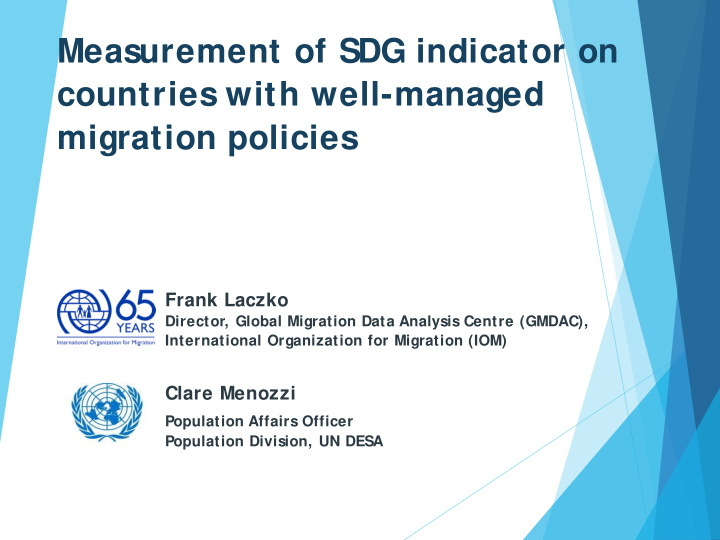



Measurement of SDG indicator on countries with well-managed migration policies Frank Laczko Director, Global Migration Data Analysis Centre (GMDAC), International Organization for Migration (IOM) Clare Menozzi Population Affairs Officer Population Division, UN DESA
Sustainable Development Goal target 10.7 Facilitate orderly, safe, regular and responsible migration and mobility of people, including through the implementation of planned and well-managed migration policies
Indicators of SDG target 10.7 10.7.1 Recruitment cost borne by employee as a proportion of yearly income earned in country of destination (ILO and World Bank) 10.7.2 Number of countries with well-managed migration policies (UN DES A and IOM)
DESA-PD / IOM collaboration to develop the methodology and measurements for SDG indicator 10.7.2 Concept and measure of “ number of countries with well-managed migration policies” based on: Conceptual framework: the ‘ Migration Governance Framework’ (MiGOF), welcomed by the IOM’s Council at its 106 th session in November 2015 Data source: the UN Inquiry among Governments on Population and Development (UN DES A)
MiGOF is comprised of three principles and three objectives
The United Nations Inquiry among Governments on Population and Development Mandated by the General Assembly in 1962 First Inquiry conducted in 1963 Conducted on behalf of the S ecretary-General, through the Permanent Missions to the UN in New Y ork The scope of the inquiries has changed over time, with changing policy priorities in the world Eleventh Inquiry (May 2014) is divided into three modules: Population S ize, Growth and Distribution I. Fertility, Family Planning and Reproductive Health II. International Migration III. Greater emphasis on programmatic measures The Inquiry responses on policy variables are codified into the World Population Policies Database
Migration module in the Eleventh Inquiry 26 questions on: • Policies on immigration • Policies on emigration • Measures on integration of immigrants • Policies on naturalization and citizenship • Measures on irregular immigration • Measures on diaspora’s investments including remittances
The Inquiry: Moving forward Greater involvement and ownership by Member S tates in the design and implementation of the Inquiry Improved coordination with partner agencies Possibility of more focused modules on specific topics, including migration Example: UN DES A-IOM collaboration on the development and implementat ion of the methodology for S DG indicator 10.7.2.
The six proposed domains and proxy measures for SDG indicator 10.7.2 Domain Proxy measure Degree to which migrants have equity in access to 1. Migrant rights services, including health care, education, decent work, social security and welfare benefits 2. Whole of government / Dedicated institutions, legal frameworks and evidence-based policies policies or strategies to govern migration 3. Cooperation and partnerships Government measures to foster cooperation and encourage stakeholder inclusion and participation in migration policy Government measures to maximize the 4. S ocioeconomic well-being development impact of migration and the socioeconomic well-being of migrants Government measures to deliver comprehensive 5. Mobility dimensions of crises responses to refugees and other forcibly displaced persons 6. S afe, orderly and regular Government measures to address regular or migration irregular immigration
Migrant rights 1. Does the Government guarantee foreign citizens equal access as citizens to the following services, welfare benefits and rights? [Please select all that apply.] Y ES R EGARDLESS OF O NL Y FOR THOSE WITH LEGAL IMMIGRATION LEGAL IMMIGRATION S N O UBCATEGOR Y STATUS STATUS a. Essential and/ or emergency health care b. Public education c. Equal pay for equal work d. S ocial security e. Access to j ustice
Summary timeline 2nd semester 2017 and 1st semester 2018: Validation and testing of the methodology, including country consultations 2 regional workshops (ECLAC and ES CAP) 3 online consultations/ workshops (ECA, ECE, ES CWA) 2nd semester 2018: Data collection, database generated and results presented Request for graduation from tier III submitted and granted. Validated data integrated into analytical outputs (reports, briefs, fact sheets, etc.) 1st quarter 2019: Publication and dissemination of analytical outputs, in anticipation of the 2019 HLPF review of goal 10
MGI Framework and methodology to assess country-specific migration governance structures Tool to enhance government’s policy capacity, and policy coherence Voluntary, government involvement, consultative
4 step process Data collection Interministerial Final Introduction and draft 4 3 2 1 multistakeholder country meeting assessment (by dialogue profiles EIU) – MGI countries – Pilot phase: Bahrain, Bangladesh, Canada, Costa Rica, Germany, Ghana, Italy, Mexico, Moldova, Morocco, South Africa, South Korea, Sweden, The Philippines and Turkey. – Roll-out: Colombia, Dominican Republic, Ecuador, El Salvador, Honduras, Kazakhstan, Kenya, Kuwait, Mali, Mauritius, Portugal, Serbia, Sri Lanka and Uganda.
10.7.2 and MGI 10.7.2 MGI Global monitoring of S National monitoring DG Voluntary Voluntary IAEG-S Capacity building DG rigorous process S Policy coherence tatistical exercise Builds on existing survey No ranking Consultative Consultative UNDES In depth A / IOM partnership
Recommend
More recommend